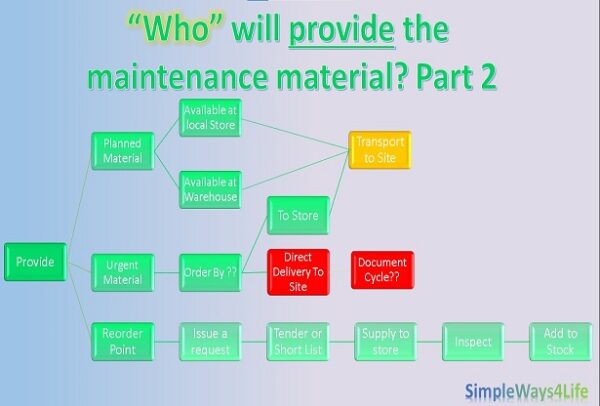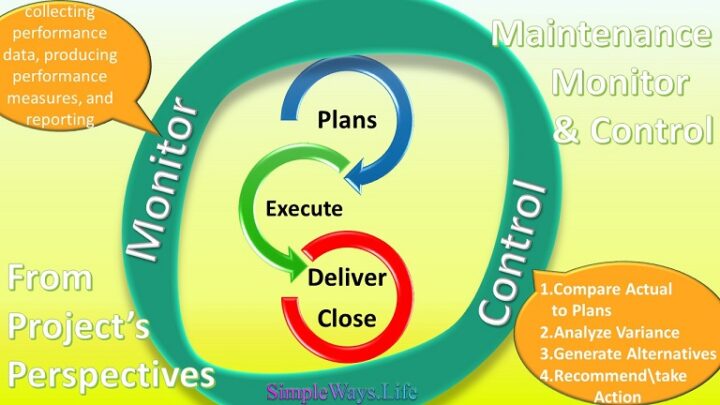This question might seem simple but actually it has many folds to answer. The word “provide” has the sense of “make available” .Does it mean to make the maintenance parts, consumables and tools available in general stores, in maintenance pilot stores, at assembly locations of, at installation location? Every scenario of those has its own roles and responsibilities. This roles might be extended across several work groups or even business groups within the organization. Even the the “provide” scenario differs based on the trigger. A sudden failure can trigger different provide scenario than a planned maintenance. The trigger of unavailable part in store can trigger urgent supplier communication by purchasers or maintainers. Let’s build some of these scenarios.
Where are we heading by growing the maintenance management maturity?
In the previous chat, The Roles in the Materials Management Cycles-Part 1, we had built a basic model for materials management out of 4 steps. Those steps were, Trigger, provide, use and repair/discard. We had discussed triggers in the previous chat together with some propping questions to help us set the roles at this stage. Since out target of this series is to grow our maintenance management maturity, we need to understand our target in the first place.
Maintenance
Maintenance is Restoring and keeping asset’s good condition so it can be used to its full productive capacity
Secrets of building a maintenance program
Management
It is the art and science of managing resources of the business
Wikipedia
Maturity
The quality or state of having completed natural growth and development. Or, the quality or state of having attained a final or desired state. Or, the quality or state of having achieved a low but stable growth rate
Merriam-Webster
So in short, Maintenance Management Maturity is achieving a desired state or growth rate regarding the restoring and keeping asset’s good condition by applying the art and science of managing resources of the business. It is science when it has a structured well-crafted known steps of doing it. And. it is an art when creativity helps us reach the next level.
Let’s start by a basic scenario, then we elaborate on other scenarios based on it.
Basic Scenario 1; Provide the materials needed for the next maintenance
Based on the maintenance schedule the planner had selected the tasks that are needed during next week’s shutdown. The maintenance schedule includes the maintenance activities and their cycles. SOP’s -Standard Operating Procedures- for each task shows the task details including the parts, consumables and tools needed. There are other vital details for each task which we had covered in our Secrets of building a maintenance Program Trainings

CUSTOMPRICE-TO2JAN26
Now the planner knows what materials are needed to be ready by the coming maintenance. What’s next?
- Does these materials exist in the local or main warehouses?
- Who will confirm that they exist? Planner, maintainer, warehouse team?
- Does the system automatically distribute the materials request and ask for confirmation?
- How these materials are booked?
- Suppose that all the materials and tools exists and confirmed, Who will transfer these to utilization location?
- More Importantly, how & when the transfer will occur.
- Who is responsible for the transportation?
- Does some material needs preparations before usage? Who and when this will be done?
Let’s take a practical example,
A motor needs a ball bearing change on the next maintenance.
- Shall we replace the installed motor with a new or refurbished one?
- Is the other motor ready and tested? Who will make it ready and confirm this?
- We shall change the ball bearing and install the motor again.
- Shall we do this onsite or in workshop?
- Are the ball bearing, grease, seals, coupling, tools, etc. ready?
- Who will make all of this available at the work location?
- Does the motor needs alignment? by Whom?
- On the other hand, In case this ball bearing size and type is not available in store,
- Can we provide it before the date of the job?
- Can we postpone the job till the ball bearing is provided?
- Who can take this decision? How he can systematically select whether to postpone or purchase the ball bearing in the coming few days?
- By the way, What are the work standards we apply in the organization?
- Does the standard implies no storage for the parts available on shelf in the local market? i.e. When we need this part we shall pick it up from an agreed vendor. Or, the vendor will bring it.
- What about the parts purchased within a short period, shall we deliver it to site or to store?
- Finally, Who will close the purchasing cycle?
Important points to takeaway from the “provide” standard scenario:
If you can see most of these questions has “Who” key word, and then the “How”. First thing is that we need to add those answers to the SOP’s. Not with persons’ names but with the job roles. So, whomever carries this job role will do this function. The naming comes as a next step when distributing the tasks. Don’t expect that all team members will jump on to the tasks that they are expected to do as a part of their job description.
Giving a task without explaining the how is not always a good selection. Because some of us can’t figure out solutions of their own without guidance. Moreover, some of us need a clear stepped process to do the task. Usually, the bottle necks or the uneasy parts of any task involves interactions with other teams or requests to other teams. Those request are not a request for a favor but a request to do a job in their scope. Even support between teams is not a favor it is a part of the responsibilities of our colocation together.
To make things easy, roles and responsibilities should be clearly analyzed and written in a reference job description we can return to. Moreover, the how also is needed in the context of the team capabilities i.e. what they can do or what they can’t do. Like you give a task to the maintenance team to move a 1/2 ton motor tot he workshop without knowing where are the lifting tools. Suppose that the heavy lifting tools belong to the warehouse team, will they provide it on time and in location? Will they do it as a favor or as a part of their job. What is the priority of using the tools? What if it was a 2 ton motor? do they have a long reaching lifting tool for a 2 ton motor at a congested location?
Advanced Scenario 2; Provide a part not in store, not purchased before on urgent bases
The first question is: Who will define the parts and their technical specs? Obviously they are the maintenance or the technical team. Next one, Who will define the expected suppliers? Should we call the manufacturer? A maintenance company to perform the job? A supplier of the parts needed? Do we need special skills and tools. After that comes who will initiate then who will continue the communication? Does the system allow the technical team to speak to suppliers and request parts directly? If not, is it a necessity? Why we don’t ask for a change?
After the selections of all these “Who” and “How” to set a system for emergency response regarding providing the material needed to recover from an emergency situation, there is one more vital thing to care about. The document cycle of the materials movement that occurred during an emergency situation. Yes, we may program a lot of shortcuts or bypasses to regular procedures in order to fulfill one of the ultimate maintenance targets which is operations recovery in the shortest possible time after a failure. But, this disrupts the warehouse, finance, and purchase cycles. How to properly close the job so it is properly closed from all disciplines not only the maintenance point of view.?
That’s one of the important takeaways. All the organization business units work together to achieve a common target. Creating or forcing winners and losers within the organization body won’t streamline the team efforts. It turns it into a fight or combat arena where if you won today, someone will try to force you losing tomorrow so he can be the sole winner and so on.
In conclusion,
Create scenarios for how to provide maintenance materials. Then, clearly assign the roles and responsibilities in those scenarios. This will allow us to perform the real show as good as the rehearsal. We need to ensure consciousness and logic around these roles distribution. Otherwise, if we forced a team to be responsible of one task in the cycle of material providing and this team is not able to perform this role, like this we had destined the complete show to fail.
If you feel you need help with any of these ideas we discussed, request a Management Consultancy or Coaching Services From our Store










One Comment